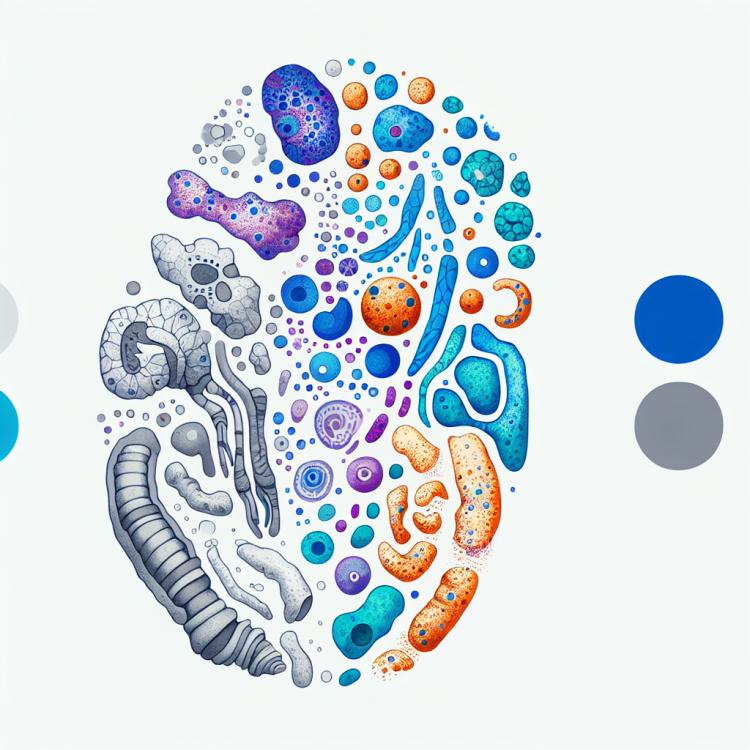
Proteus syndrome: characteristics of manifestation and modern treatment methods
Understanding Proteus Syndrome
Proteus syndrome, also known as elephantiasis or Proteus disease, is a rare genetic disorder caused by mutations in the AKT1 gene. It is characterized by asymmetric hypertrophic growth of muscles, bones, and skin, leading to unusual body shape and tumors resembling uncontrolled growth.
Understanding Proteus syndrome is crucial for determining appropriate treatment methods and managing the disease’s consequences. Early diagnosis, medical monitoring, and surgical interventions can help patients with this rare inherited disorder improve their quality of life and reduce complications.
Etiology of Proteus Syndrome
The Proteus syndrome, a rare genetic disorder, is caused by mutations in the AKT1 gene. This gene encodes a protein that is involved in signaling pathways that control cell growth and division. Mutations in the AKT1 gene lead to abnormal activation of the AKT/mTOR signaling pathway, contributing to irreversible hypertrophic growth of cells and tissues in patients with Proteus syndrome.
Additionally, transgenic mutational events like somatic mosaics during embryonic development play an important role in shaping the phenotype of Proteus syndrome. These mutations occur at early stages of embryonic development and lead to a mosaic distribution of altered cells throughout organs and tissues, which explains the variety of clinical manifestations of this syndrome.
- Mutation of the AKT1 gene: Proteus syndrome arises due to mutations in the AKT1 gene, which is responsible for cell growth and division.
- Activation of the AKT/mTOR signaling pathway: Mutations in the AKT1 gene lead to abnormal activation of the AKT/mTOR signaling pathway, contributing to hypertrophic growth of cells and tissues.
- Transgenic mutations: Somatic mosaic mutations that occur at early stages of embryonic development play a key role in the phenotype of Proteus syndrome.
- Mosaic distribution of altered cells: Mutations lead to a mosaic distribution of altered cells throughout organs and tissues, explaining the various clinical manifestations of the syndrome.
- Genetic factors: Heredity and genetic anomalies play a significant role in the occurrence and manifestation of Proteus syndrome.
Clinical picture of Proteus Syndrome
The clinical picture of Proteus Syndrome is characterized by various congenital anomalies, such as hypertrophy and deformations of bones and tissues, benign tumors, including lymphangiomas and hemangiomas. Patients with this syndrome may also have skin changes, vascular defects, brain abnormalities, seizures, intellectual disabilities, and other associated disorders. Symptoms of the syndrome can manifest in early childhood and continue throughout life, requiring comprehensive medical intervention and support.
Although the symptoms of Proteus Syndrome can vary significantly from patient to patient, modern diagnostic methods such as educational examinations, genetic testing, and biopsy samples help in establishing a diagnosis and determining an individualized treatment plan for each specific case.
- Bone and tissue hypertrophy: is characterized by unusual growth and deformations of skeletal structures.
- Benign tumors: include lymphangiomas and hemangiomas, which can occur on the skin and internal organs.
- Skin changes: include cutaneo-osteodysplastic fibroma, which is characterized by lesions of the skin and bones.
- Vascular defects: can lead to anomalies in the circulatory system and problems with blood circulation.
- Brain anomalies: can manifest as seizures, developmental delays, and other neurological symptoms.
Approaches to the treatment of Proteus Syndrome
The treatment of Proteus Syndrome is a complex and multifaceted process requiring a combined approach from a variety of specialists, such as surgeons, orthopedists, geneticists, neurologists, and others. An individualized treatment plan is determined based on the clinical picture of each specific patient, taking into account all the characteristics of the syndrome and its manifestations.
Experts in the treatment of Proteus Syndrome emphasize the importance of early diagnosis and comprehensive therapy, which includes not only surgical intervention to correct deformities and tumors but also rehabilitation activities, accompanying therapy, and genetic counseling. The development of new treatment methods, such as targeted therapies and gene therapy, helps expand the opportunities to combat the negative manifestations of the syndrome and improve the quality of life for patients.

Diagnosis of Proteus Syndrome
The diagnosis of Proteus Syndrome involves a comprehensive approach, starting from a thorough clinical examination to identify physical features and symptoms characteristic of this genetic disorder, to the use of modern genetic tests to detect mutations in the AKT1 gene. Clinical methods, such as educational assessments and visual evaluations of deformities and tumors, combined with advanced genetic diagnostic technologies, help doctors establish an accurate diagnosis and develop an individualized treatment plan for patients with Proteus Syndrome.
In addition to clinical and genetic diagnostic methods, imaging techniques such as X-ray, computed tomography (CT), and magnetic resonance imaging (MRI) may be used to assess internal organs, tissues, and bones, to further confirm the diagnosis and identify characteristic anomalies associated with this genetic syndrome.
- Clinical examination: Doctors perform a thorough physical examination, paying attention to general symptoms and physical abnormalities characteristic of Proteus Syndrome.
- Genetic testing: Modern genetic diagnostic methods allow for the identification of mutations in the AKT1 gene associated with the development of the syndrome.
- Imaging methods: X-rays, computed tomography (CT), and magnetic resonance imaging (MRI) allow visualization of internal structures to identify deformities and tumors.
- Biopsy: In cases of suspicion of tumors or tissue abnormalities, a biopsy may be performed to establish an accurate diagnosis.
- Consultation with specialists: A multidisciplinary approach involves consultation with geneticists, oncologists, surgeons, and other specialists to establish a diagnosis and develop a treatment plan.
Treatment of Proteus Syndrome
Additionally, individual treatment may include symptomatic measures to improve the quality of life for patients with Proteus Syndrome, such as pain management, control of epileptic seizures, correction of intellectual impairments, and other approaches aimed at reducing clinical manifestations and improving long-term treatment outcomes.
- Surgical intervention: Surgical operations may be performed to correct deformities of bones and tissues, as well as to remove tumors, reducing functional and cosmetic issues.
- Physiotherapy and rehabilitation: Physiotherapy procedures can help improve muscle strength, mobility, and coordination in patients with Proteus syndrome.
- Treatment of comorbidities: Managing epileptic seizures, pain management, and other symptoms can help improve the quality of life for patients with Proteus syndrome.
- Psychological and social support: Patients and their families may require support from psychologists, social workers, and other specialists to cope with emotional and practical difficulties.
- Individualized approach: An individualized treatment plan is developed for each patient considering their unique clinical manifestations and needs to ensure the best outcomes and improve quality of life.
Prevention of Proteus Syndrome
To prevent or reduce the frequency of complications associated with the symptoms of the syndrome, timely seeking medical help is crucial, along with regular comprehensive examinations to detect changes and timely interventions to prevent the progression of the pathology. Professional management of the condition and timely treatment can help improve the quality of life for patients and reduce the risk of severe consequences of the syndrome.
- Genetic counseling: Providing families with information about the possibility of inheriting a genetic disorder and assessing the risk, especially in the presence of AKT1 gene mutations.
- Risk monitoring: Regularly tracking the likelihood of syndrome development in close relatives of patients and conducting genetic testing if necessary.
- Reproductive planning: Providing recommendations for pregnancy and childbirth planning considering the risk of syndrome inheritance.
- Medical monitoring: Regular examinations to detect changes, early diagnosis, and intervention to prevent the progression of the pathology.
- Seeking medical help: Timely treatment of syndrome symptoms to prevent complications and improve patients’ quality of life.
Interesting aspects of Proteus Syndrome
Another interesting aspect is that Proteus syndrome can manifest at different ages and with varying degrees of severity of clinical symptoms, complicating the diagnosis and treatment of this condition. Research in this area continues, and the development of innovative diagnostic and therapeutic methods will help improve the prognosis and quality of life for patients with Proteus syndrome.